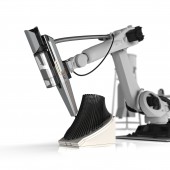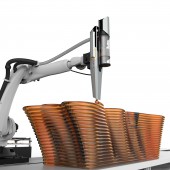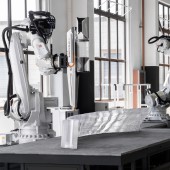DESIGN NAME:
Pellet-X
PRIMARY FUNCTION:
City Building 3D Printer
INSPIRATION:
PELLET-X construction 3D printing guns are capable of being equipped with 6-axis and above industrial robots, achieving flexible printing of large construction components and structures. Users can directly import the 3D data information of the building model into the printing and processing master control platform. With a friendly human-machine interaction interface, it is easy for users to control the process and finish the printing task with high accuracy and efficiency.
UNIQUE PROPERTIES / PROJECT DESCRIPTION:
The appearance of PELLET-X changes the bulky feeling of traditional sheet metal parts through the design of multi-faceted bending, hollow patterns and other decoration. The design of hollow surface overlaying clear parts, on the one hand, is a kind of color decoration. On the other hand, users can see the inner workings of the printer through transparent parts such as R+. Also, the device has a strong adaptability of a wide range of printing materials. With common plastic pellets as printing material, the cost will be reduced by 75% compared to wire printing. The main printing material of PELLET-X is PETG. It also supports the printing of a variety of mainstream materials and their modified products, such as high-temperature resistance, fiber reinforcement, toughness enhancement and other modifications to PLA, PETG, PC, TPU, nylon and other materials. In addition, smart 3D printing devices can extrude thermoplastic materials with melt temperatures below 400°C, which can be recycled and reused.
OPERATION / FLOW / INTERACTION:
In terms of hardware, PELLET-X owns a 6-axis and above control system, which break the limits of traditional 3-axis control system, with greater freedom and flexibility in the printing process. And it breaks through the traditional FDM printing mode by linking the robot with external axes and rails and other equipment, achieving rapid printing of complex shapes and large components. The device can also print hollow three-dimensional structures and ensure the load capacity of space structures.
In terms of software, the device is equipped with a simple and friendly human-machine interface. General workers can easily master the operation of the industrial robots with only a few hours of training, which greatly reduces the training cost. Besides, the machine realizes fully automatic adjustment of parameters during the printing process such as real-time extrusion volume, cooling volume, feed volume and temperature.
PROJECT DURATION AND LOCATION:
The PELLET-X printing gun started its design in June 2018. Its first generation finished design and production in August 2019. PELLET-X, the second generation, was completed in August 2019 and officially delivered to customers in June 2020.
|
PRODUCTION / REALIZATION TECHNOLOGY:
In terms of hardware, PELLET-X owns a 6-axis and above control system, which break the limits of traditional 3-axis control system, with greater freedom and flexibility in the printing process. And it breaks through the traditional FDM printing mode by linking the robot with external axes and rails and other equipment, achieving rapid printing of complex shapes and large components. The device can also print hollow three-dimensional structures and ensure the load capacity of space structures.
In terms of software, the device is equipped with a simple and friendly human-machine interface. General workers can easily master the operation of the industrial robots with only a few hours of training, which greatly reduces the training cost. Besides, the machine realizes fully automatic adjustment of parameters during the printing process such as real-time extrusion volume, cooling volume, feed volume and temperature.
SPECIFICATIONS / TECHNICAL PROPERTIES:
-
TAGS:
Roboticplus, Construction Robot, 3D Printing, Printing Gun, Environmental Printing
RESEARCH ABSTRACT:
Currently, there are mainly three demands for 3D printing solutions, large size components printing and hourly production volumes, monolithic molding printing and complex shape printing. In the construction process, traditional buildings usually use assembly methods such as temporary bulk and manual assembly, prone to large size errors, tight seams and other problems. The technology of 3D printing can form large scale building components in one step and produce high quality building products, reducing splicing nodes and tedious assembly work, with lower time and labor costs. However, the maximum component size of desktop 3D printing is 500mm*500mm*500mm with an hourly output of 100g/h. Therefore, there is an urgent need for 3D printing solutions to be applied in the construction field to meet the demands of large size components and output.
CHALLENGE:
Architectural 3D printers can encounter problems including screw discharge, insufficient cooling leading to collapse untimely material supply, poor exhaust, and jamming during the printing process. In order to realize the integrated molding of architectural 3D printing, we continuously tested and finally designed the stable and reliable smart 3D printing equipment with strong overall molding capability, which not only improves the finished product rate, but also reduces the project cost. Furthermore, designers need to know the current pain points of the traditional construction industry, have a foundation in design and construction, and fully understand the nature of mainstream printing materials so that the products can fully meet the needs of the industry.
ADDED DATE:
2021-03-03 07:22:49
TEAM MEMBERS (2) :
Fan Wu and Hao Meng
IMAGE CREDITS:
Fan Wu and Hao Meng, 2020.
|









